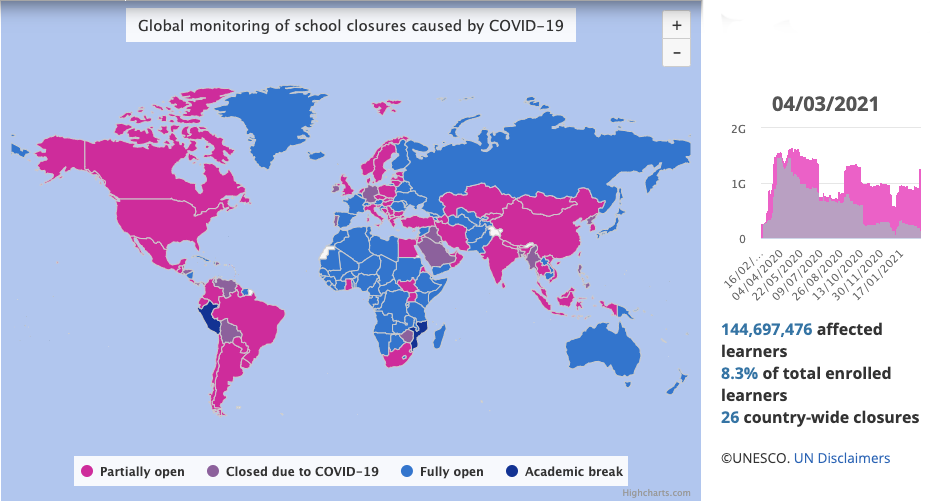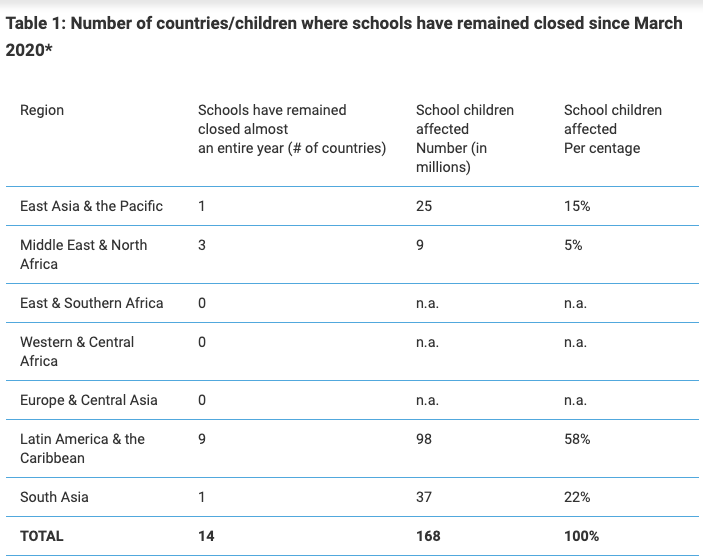
New York: At least 1 in 7 children – or 332 million globally – has lived under required or recommended nationwide stay-at-home policies for at least nine months since the start of the COVID-19 pandemic, putting their mental health and well-being at risk, UNICEF warned today.
While almost all children worldwide have lived under some form of intermittent lockdowns for the last year, the new analysis by UNICEF, which uses data from the Oxford COVID-19 Government Response Tracker, identifies some of the most enduring lockdown conditions worldwide.
According to the analysis, 139 million children globally have lived under required nationwide stay-at-home orders for at least nine months since COVID-19 was characterized as a pandemic on 11 March 2020 – meaning they are required to stay at home with few exceptions – including children living in countries such as Paraguay, Peru and Nigeria. The rest of the 332 million – or 193 million – have lived under recommended nationwide stay-at-home policies for the same amount of time.
Also read:
- COVID-19 pandemic is warning bell for the world to scale-up in investment in mental health
- WHO survey of 130 countries shows the devastating impact of COVID-19 on access to mental health services
“With nationwide lockdowns and pandemic-related movement restrictions, it has been a long year for all of us, but especially for children,” said UNICEF Executive Director Henrietta Fore. “When – day after day – you are away from your friends and distant loved ones, and perhaps even stuck at home with an abuser, the impact is significant. Many children are left feeling afraid, lonely, anxious, and concerned for their future. We must emerge from this pandemic with a better approach to child and adolescent mental health, and that starts by giving the issue the attention it deserves.”
As the pandemic enters its second year, the impact on children and young people’s mental health and psychosocial well-being is taking a toll. In Latin America and the Caribbean, a recent UNICEF U-Report poll of young people generated more than 8,000 responses and found that more than a quarter had experienced anxiety, and 15 per cent depression.
Even before the pandemic, children and young people carried the burden of mental health risks, with half of all mental disorders developing before age 15, and 75 per cent by early adulthood. The majority of the 800,000 people who die by suicide every year are young people, and self-harm is the third leading cause of death among 15–19-year-olds, with higher rates among adolescent girls. It is estimated that globally 1 in 4 children live with a parent who has a mental disorder.
For children experiencing violence, neglect or abuse at home, lockdowns have left many stranded with abusers and without the support of teachers, extended families and communities. Children in vulnerable population groups – such as those living and working on the streets, children with disabilities, and children living in conflict settings – risk having their mental health needs overlooked entirely.
“Countries must dramatically invest in expanded mental health services and support for young people and their caregivers in communities and schools. We also need scaled-up parenting programmes to ensure that children from vulnerable families get the support and protection they need at home,”Henrietta Fore, UNICEF Executive Director, said.
It goes without saying that school closures are having devastating consequences for children’s learning and wellbeing. The most vulnerable children and those unable to access remote learning are at an increased risk of never returning to the classroom, and even being forced into child marriage or child labor. According to latest data by UNESCO, more than 888 million children worldwide continue to face disruptions to their education due to full and partial school closures.
The majority of schoolchildren worldwide rely on their schools as a place where they can interact with their peers, seek support, access health and immunization services and a nutritious meal. The longer schools remain closed, the longer children are cut off from these critical elements of childhood.
On March 3, Fore had pointed out the one-year mark of the COVID-19 pandemic was a reminder of the catastrophic education emergency worldwide lockdowns had created. “With every day that goes by, children unable to access in-person schooling fall further and further behind, with the most marginalized paying the heaviest price. We cannot afford to move into year two of limited or even no in-school learning for these children. No effort should be spared to keep schools open, or prioritise them in reopening plans,” she had said.
But, as UNICED pointed out in a report, even as students return to their classrooms, they will need support to readjust and catch up on their learning. School reopening plans must incorporate efforts to recover children’s lost education.
It will be an onerous task to say the least. Latest updated data released on March 3, 2021 by UNICEF that reflect school closure status over the past 11 months since 11 March 2020 to February 2021, reveals that schools for more than 168 million children globally have been completely closed for almost an entire year due to COVID-19 lockdowns. Furthermore, around 214 million children globally – or 1 in 7 – have missed more than three-quarters of their in-person learning. (The analysis has covered from the pre-primary education to the upper secondary education. In cases where countries had less than 10 days of fully opened schooling and less than 12 days of partially open schooling, they were deemed as remaining closed for almost a year of instruction time).

The analysis on school closures report notes that 14 countries worldwide have remained largely closed since March 2020 to February 2021. Two-thirds of those countries are in Latin America and the Caribbean, affecting nearly 98 million schoolchildren. Of the 14 countries, Panama has kept schools closed for the most days, followed by El Salvador, Bangladesh, and Bolivia.

To call attention to the education emergency and raise awareness about the need for governments to keep schools open, or prioritise them in reopening plans, UNICEF today unveiled ‘Pandemic Classroom,’ a model classroom made up of 168 empty desks, each desk representing the million children living in countries where schools have been almost entirely closed – a solemn reminder of the classrooms in every corner of the world that remain empty.
“This classroom represents the millions of centers of learning that have sat empty—many for almost the entire year. Behind each empty chair hangs an empty backpack—a placeholder for a child’s deferred potential,” said Fore. “We do not want shuttered doors and closed buildings to obscure the fact that our children’s futures are being put on indefinite pause. This installation is a message to governments: we must prioritize reopening schools, and we must prioritize reopening them better than they were before.”
UNICEF urged governments to prioritise the unique needs of every student, with comprehensive services covering remedial learning, health and nutrition, and mental health and protection measures in schools to nurture children and adolescents’ development and wellbeing. UNICEF’s Framework for Reopening Schools, issued jointly with UNESCO, UNHCR, WFP and the World Bank, offers practical advice for national and local authorities.
– global bihari bureau





